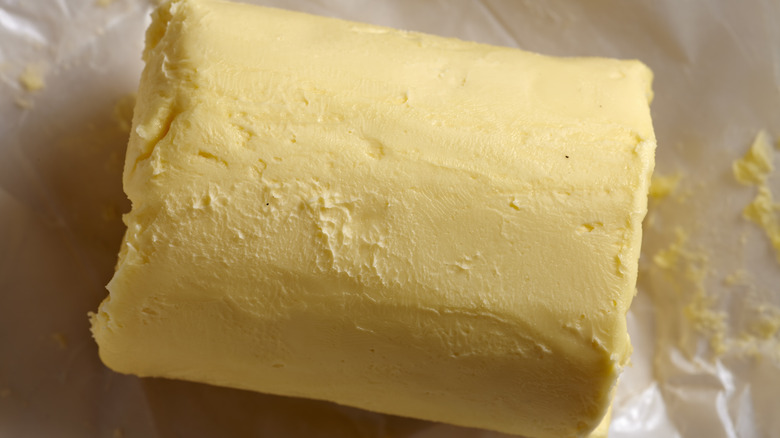Amish Butter Vs Regular: What's The Actual Difference?
If there's one thing we're passionate about, it's the ongoing quest for the best butter. Our favorite butter brand at the grocery store is one with a higher butterfat content — 82% in Kerrygold, as opposed to the more common American 80% — but we've found a butter that has not only higher butterfat still (84 to 85%), but a charming rustic aesthetic and luscious, creamy taste. We're talking about Amish butter, your new dairy obsession. If you live in Amish country around Ohio, Indiana, or Pennsylvania, you've likely already seen the hefty rolls of butter swaddled in parchment at your local farmer's market or country store.
If you are a fan of using your butter wrappers in the freezer to separate patties or filets, you may be stymied by not having traditional stick butter in your fridge. After all, conventional butter comes with handy lines for easy measuring, while Amish butter comes in rather unwieldy one- or two-pound logs. Also, if you leave your butter out on the counter, you may be dismayed to find out that a log of Amish butter simply doesn't fit in your butter dish. If you can move past these minor inconveniences, however, you will discover a world of flavor and luxuriance that makes your baked goods sing and absolutely transforms your morning toast ritual.
What makes Amish butter better?
Amish butter, like most homemade butter, has just two ingredients: cream and salt. What elevates it above other comers? The answer is the churning process. Now, not all Amish butter is hand-churned by women in long dresses, especially if you aren't located in the parts of the country where Amish people tend to settle. Even mass-produced Amish butter, however, utilizes slow churning, a process that incorporates less air into the mixture and avoids milkfat breakdown. This contributes to creating a dense, rich final product.
Some folks think that Amish butter is produced by cows fed a diet of grass, which generally contributes to nicer butter, but this isn't always the case. It is true, as some skeptics allege, that a lot of the mystique behind "Amish butter" is a marketing ploy, as the name conjures images of pastoral, more wholesome products, when, in fact, the butter may simply be creamier and rolled into an interesting shape. If you are purchasing your Amish butter from a local homestead, you are obviously much more likely to be buying an artisanal product. Elsewhere in the country, your "Amish" butter may be nicer for the table, but don't make any assumptions about it beyond the basics.

